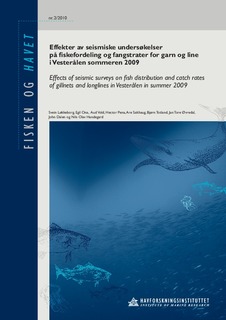| dc.description.abstract | In connection with the Norwegian Petroleum Directorate’s seismic survey off the coasts of Vesterålen in summer 2009, a project was carried out to study the degree to which commercial fishes were affected. Four chartered gillnet and longline vessels fished for Greenland halibut, redfish, saithe and haddock in the periods before (12 days), during (38 days) and after (25 days) the seismic data acquisition. The research vessel “Håkon Mosby” carried out an acoustic survey of the distributions of fish and plankton in the area. Gillnet catches of Greenland halibut and redfish rose during seismic shooting and remained higher after the end of the campaign than they had been before the start of seismic activity. Longline catches of Greenland halibut fell during the seismic campaign, but rose again in the course of the following 25-day period. The results for saithe revealed a decline (not statistically significant) in gillnet catches both during and after seismic shooting. Based on the acoustic survey estimates, the results were interpreted as an indication that saithe partly left the area. The longline catches of haddock did not reveal statistically significant differences in catch rates from before and during the seismic survey. The area in which the haddock fishery took place was less affected by the sound of the air-guns than the fishing grounds for the other species. Nevertheless, there was a decline in haddock catches when the seismic vessel approached this area. The acoustic survey of the distribution of demersal fishes confirms the results of the fishing experiments. During seismic shooting, lower concentrations of saithe were measured in the area, whereas no changes in the distribution of the other demersal fishes were observed. No changes in plankton distribution that could be ascribed to the seismic campaign were documented.
The results of this study provide clear signs that fish reacted to the sound of the air-guns in that catch rates changed (increased or fell) during the period of seismic shooting. Sound measurements showed that the fish were exposed to sound levels within a range where obvious changes in
swimming activity can be expected. These results can be explained by the fish raising their level of swimming activity, thus making the Greenland halibut, redfish and ling more liable to be taken in gillnets, while the saithe may have migrated out of the area. The rise in swimming activity may be a symptom of a stress reaction that could lead to reduced longline catch efficiency. | en |
